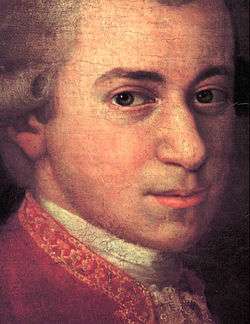Symphony No. 13 (Mozart)
Symphony No. 13 in F major, K. 112, by Wolfgang Amadeus Mozart, was written in Milan during the autumn of 1771. The symphony is in four movements, the second of which is scored for strings alone.[1] The third movement minuet may have been written earlier, and then incorporated into the symphony—the autograph manuscript shows the minuet copied in Leopold's hand.[1] Nicholas Kenyon describes Symphony No. 13 as the last in "conventional mode"—thereafter "we are in the beginnings of a different world."[2]
Movements and instrumentation
The instrumentation was: strings, 2 oboes, 2 horns, bassoon, continuo[1]
Performance details
Its probable first performance was at a concert given by Leopold and Wolfgang Mozart at the residence of Albert Michael von Mayr, on 22 or 23 November 1771.[1] This concert may also have seen the premiere of Mozart's 12th symphony.
References
Sources
- Dearling, Robert: The Music of Wolfgang Amadeus Mozart: The Symphonies Associated University Presses Ltd, London 1982 ISBN 0-8386-2335-2
- Kenyon, Nicholas: The Pegasus Pocket Guide to Mozart Pegasus Books, New York 2006 ISBN 1-933648-23-6
- Zaslaw, Neal:Mozart's Symphonies: Context, Performance Practice, Reception OUP, Oxford 1991 ISBN 0-19-816286-3
External links
- Sinfonie in F KV 112: Score and critical report (German) in the Neue Mozart-Ausgabe
- Symphony No. 13: Scores at the International Music Score Library Project
